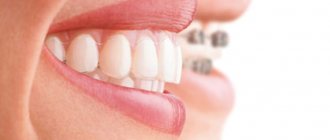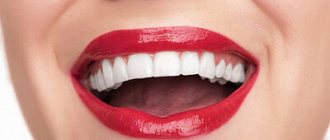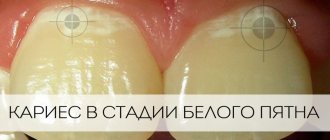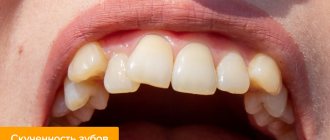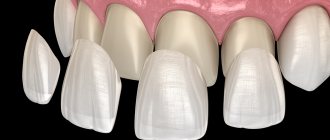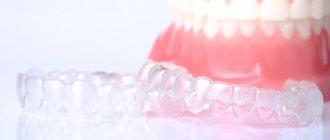Crooked teeth cause a lot of inconvenience: a person is embarrassed to smile, talk, or take pictures. Modern dentistry offers many options for solving the problem, but straightening teeth with the help of unesthetic braces does not attract patients. The PROPRICUS clinic in Moscow straightens teeth without braces, turning treatment into a process that is comfortable for the person.
Need some advice?
Enter your phone number and we will give you a free consultation
I want a consultation
*By making an appointment you consent to the processing of your data
In what cases is teeth straightening necessary?
Smooth and beautiful teeth are the dream of many people. After all, not everyone was given a perfect smile at birth. Dental abnormalities can be the result of poor heredity, trauma, or improper dental care in childhood. If you clearly see that your teeth are crowded, your teeth protrude greatly from the dentition, or there are other deficiencies, you should contact an orthodontist. Sometimes the problem is far-fetched, but only a specialist can determine this. A preliminary diagnosis will be made at the first appointment, and then the doctor will be able to offer treatment options.
What is malocclusion?
In dentistry, a pathology such as malocclusion is the presence of contact between the upper and lower dentition in the position of central occlusion. The manifestation of malocclusion can be either too noticeable or completely insignificant, and in special cases, the chewing function of the jaw is disrupted and visible changes begin to occur.
When visiting a clinic as an adult, surgical intervention is not only not recommended, but it will not bring an optimal result. Most often, the detection of malocclusion occurs in the presence of a slight disturbance in the closure of the dentition, which allows the defect to be eliminated without taking serious measures.
Important: Experts recommend contacting dentists as early as possible in order to avoid serious consequences in the form of distortion of facial features and high financial costs.
Is it possible to straighten teeth in adults?
Of course, treatment is faster in children and adolescents. This is due to the fact that up to the age of 25 in a person, the processes of bone tissue regeneration proceed faster, the ossification of bone sutures has not yet been completed, which means orthodontic treatment will be more effective. But don’t think that adults can’t be helped. Dentists have been successfully helping straighten teeth for patients of any age for a long time. It just takes a lot of time. Orthodontists typically recommend braces or aligners as options for straightening teeth in adults. In some cases, if only one or two teeth are misaligned, doctors may use veneers. These extremely thin dental coverings provide a quick solution to the problem of an imperfect smile. If the problem is several teeth and in addition the doctor diagnoses malocclusions, you will still have to use orthodontic structures.
What does a braces system consist of?
- Braces are miniature “brackets” that are attached to tooth enamel using dental adhesive.
- An orthodontic arch is a thin and elastic wire that connects braces. It is under specially calculated tension, delicately influencing the teeth and gradually moving them to the desired position.
- Fastenings - metal wires, elastic bands or miniature locks, with the help of which the arch is attached to the braces.
Is it possible to straighten teeth at home?
Surely many people are interested in whether it is possible to straighten teeth at home. Don’t think that this can be done with the wave of a magic wand or using folk remedies. Teeth straightening at home means the use of aligners, trainers or elastopositioners. You will not be able to choose these designs yourself. You will need to contact an orthodontist - a doctor who straightens teeth, who will conduct an examination and tell you exactly whether removable structures will help in your case. Without a specialist, you won’t be able to cope with your problem - you shouldn’t even try. Attempting to straighten teeth without an orthodontist can lead to irreversible consequences.
How to straighten teeth for an adult?
Usually, correcting the bite and straightening the teeth is usually done in childhood. At an early age, these are removable structures, for example, trainers, lip bumpers or stretching plates; starting from the age of 10–11, braces can be installed. In some cases, you can do without braces, but the orthodontist will again tell you about this. For adults, it is more difficult to carry out the procedures. The fact is that at the age of 25, a person’s bone sutures harden, and any manipulations with the bite and other problems begin to take quite a lot of time. But this does not mean that you should give up dreams of a perfect smile. Answer to the question: “Is it possible to straighten teeth at 30 and beyond?” - of course, yes. At the first appointment, the orthodontist will tell you how to straighten teeth for an adult and what exactly to use in your case.
When can a malocclusion be corrected?
Malocclusion can be corrected at any age. This has been confirmed by numerous studies and the experience of our patients.
For each age, it is recommended to use certain braces. They regulate both the time of the procedure and its effectiveness. For example, for children under 16 years of age, you can choose any braces - from metal to lingual. At a more mature age, it is worth paying attention to self-regulating braces - their functional features allow you to obtain optimal results in a relatively short time.
Important: Bite restoration is not the most terrible procedure. Therefore, you should not wait until health problems or complexes take over - just contact one of our clinics and be beautiful.
What ways are there to straighten teeth?
An orthodontist straightens teeth in several ways, as we have already mentioned. Let's talk about the most popular ones. The most popular way to straighten teeth is still the use of braces. Braces vary in material, location on the teeth and the presence of a ligature. However, regardless of the type, they regularly perform their functions - treating almost all malocclusions and incorrectly positioned teeth. You can inexpensively straighten your teeth and get rid of other problems by wearing metal vestibular (located on the outside of the dentition) braces.
If braces are not an option for you, you can straighten your teeth without braces using aligners. They solve several dental problems at once - they remove gaps between teeth, correct crowding and other malocclusions. One of the most popular brands is Invisalign aligners. Mouthguards are created taking into account individual characteristics, do not break and are almost invisible when worn. You can get used to them quite quickly. On average 10 – 12 hours. However, you will need to wear such mouthguards for more than 20 hours every day. You will need to accustom yourself to this, otherwise you will not achieve a good result.
Teeth straightening devices
There are two most popular orthodontic teeth straightening systems - braces and aligners (aligners). Each has its own characteristics. Braces have been used for many decades. They differ in several parameters, for example, in material. All types of braces are equally effective. This method of treatment is time-tested. In addition, braces systems are improved every year. Even metal braces have changed and turned from creepy “brackets” into a rather neat design. In parallel with bracket systems, other technologies are also developing. Thus, several years ago Invisalign aligners became widely used. Despite the high cost, their popularity has grown in a matter of months due to the following advantages:
- are created individually for each patient, taking into account his physiological characteristics
- invisible to others
- convenient for daily use
- do not require complex care
Braces
The designs allow you to level out any, even the most complex pathologies. The device consists of the braces themselves, which are individually attached to the teeth, and an arch - under its pressure, the dentition is rearranged into the correct position. Depending on the complexity of the anomaly, you will have to wear the device from six months to two years, regularly visiting a doctor. He will record changes and adjust the system. The main disadvantage of braces is their visibility, but today there are models that provide the opportunity to hide the treatment process from others. For example, ceramic and sapphire systems are white and blend in with the enamel, and lingual braces are completely invisible because they are installed on the inner wall of the teeth.
Aligners
Another device for straightening teeth is silicone aligners. They are made from transparent material based on the patient’s personal jaw casts, so they are completely invisible on the dentition. Another advantage of aligners is that they can be removed during meals or, for example, business negotiations. Treatment with aligners does not require frequent adjustments; it is enough to visit an orthodontist once every two months. You yourself change the devices from the kit every two weeks, the doctor only monitors the process. The device must be worn at least 22 hours a day, then the first results will appear within a month.
Prosthetics
For minor crooked teeth, crowns or veneers are used. They do not correct real teeth, but only mask malocclusions, but you can see the effect immediately after installing the structures. Crowns are used if the teeth are more than half destroyed - they are ground down and dentures identical to natural teeth are put on. Veneers are fixed in the smile area and hide aesthetic defects such as chips or gaps between teeth. The structures are created individually for each patient - the specialist selects the desired color and then gives them the anatomical shape of the surface of the teeth. However, these records have one significant drawback. Which? We'll talk about this below.
Massage can speed up healing
There are several ways to make the process of correcting dental anomalies less painful. One of them is massage of the gums and palate. Experts recommend using this method during oral care procedures. Gently, without force or sudden movements, massage the gums with a medium-hard brush, performing circular movements on each jaw. This will improve blood circulation, speed up the process of straightening the teeth, reduce pain, and if repeated regularly, strengthen the gums and prevent loosening of the teeth.
Surgical teeth straightening
Is it possible to straighten teeth surgically? We can say that it is impossible to surgically correct the position of the teeth, but it is possible to change the bite. The surgical method of bite correction is used only when orthodontic treatment alone is not enough.
Surgical correction of the bite, or orthognathic surgery, is only indicated for patients with noticeable skeletal deformities that result in abnormal jaw and chin size. The operation is performed in a hospital setting under general anesthesia; the entire procedure usually takes about 6 hours. Like any other major surgery, this procedure has a recovery period. The patient will be able to return to a full life after 3 to 4 weeks. However, in any case, treatment always begins with orthodontic teeth straightening, followed by a surgical stage, after which final orthodontic correction is necessary.
Now about correcting the bite in children of senior school age
Correcting the bite in children without braces is a youth trend
Justin Bieber trusted only aligners to straighten his teeth:
Benefits of correcting your bite without braces
- Unlike braces, aligners do not injure the oral mucosa. The edge of the tray undergoes special treatment and does not damage the gums
- The patient can remove the mouth guard while eating, and therefore there are no dietary restrictions as during treatment with braces
- Mouth guards can be removed while brushing teeth, which means the patient will not need special devices for oral hygiene
- Even the most aesthetic vestibular braces are more noticeable than clear aligners.
- The cost of treatment with invisible (relatively of course) lingual braces is often exorbitant, which cannot be said about aligners
- You can read a comparative analysis of treatment between braces and aligners in this article
Correction of bite with aligners due to diastema
Diastema can generally be corrected perfectly without braces. The aligners cope with the task 100%. In this example, treatment of the diastema took 5 months
.
Correction of bite with aligners during reverse incisal overlap
In this case, the treatment was more serious; teeth were straightened on both jaws. The duration of treatment is 15 months
.
Correcting a bite without braces using the example of spaces between teeth in the lower jaw
Teeth correction with aligners was carried out exclusively on the lower jaw and took 6 months
.
Correcting a bite with aligners using the example of turning the front teeth
Without using the lower jaw, aligners were worn only on the upper jaw. The total treatment period is 14 months.
Issues of correcting bites in adults are a separate topic that also requires detailed analysis. Read about it in the next article. Orthodontist, Ph.D. Tatyana Gevorkyan
In what cases is grinding necessary?
As we have already said, veneers are used to correct minor defects in the dentition - for example, chipped teeth, curvature of one or two teeth, as well as diastema. The main disadvantage of this method is the grinding of dental tissue to remove all irregularities. In addition, if you do not prepare your teeth before installing veneers, then after prosthetics they will look too convex and unnatural.
The structures themselves will last about ten years, after which they must be replaced with new ones, since turning teeth is an irreversible process.
Important!
To fix the veneers, the patient’s teeth are ground down by approximately 0.3 - 0.7 mm.
How do teeth become straight?
After the patient has been fitted with braces or has started treatment with aligners, the process of teeth straightening begins. The constant slight impact of the orthodontic system leads to the fact that the bone around the tooth changes: on the one hand it increases, and on the other it decreases. And the tooth moves to the desired point. It is important that the load is not excessive or insufficient - in either case, the treatment will not lead to the desired result. But an experienced orthodontist will not allow this to happen. It is to regulate the process of teeth straightening that you need to regularly visit your doctor. Treatment will last 1.5 – 2 years. After this, you will have to wear retainers for some time to fix the result.
How to straighten your front teeth?
In some cases, the dentition has slight deficiencies, for example with the front teeth. The orthodontist will tell you how to straighten your front teeth. He may recommend getting braces or treatment with aligners. However, sometimes cosmetic dentistry can help straighten the two front teeth. If there are no bite defects, you should consult an orthopedist - a doctor who specializes in prosthetics. He can offer the option of installing a veneer - an overlay 0.5 - 0.7 mm wide, which allows you to make your smile perfect. This technology has its pros and cons. An undoubted advantage is the speed with which the installation is carried out - just a few days, and the problem is solved. Here's a way to quickly straighten your teeth. Another plus is the service life. One of the disadvantages is the need to grind the tooth, and this is an irreversible process. In the same way, you can straighten 1 tooth, and not necessarily the front one. Sometimes an orthodontist suggests straightening the lower teeth without using braces or aligners and using veneers or lumineers. In each specific case, consultation with a doctor is necessary.
Factors contributing to the occurrence of pathology
There can be an incredible number of reasons why such a defect as malocclusion can occur, but there is the most basic one - heredity. In other words, if at least one of the relatives has such a defect, the probability of its manifestation in the child is 50%
An incorrect bite can occur when the facial bones are injured and even when teeth are knocked out. In this case it is noted:
- tooth displacement;
- increasing the space between teeth;
- the appearance of a change in the nature of the closure of the upper and lower dentition.
There is one more reason that cannot be ignored, and this is the partial or complete absence of breastfeeding in newborn age. For this reason, pathologies can occur extremely rarely, but this is quite possible. Experts believe that the process of sucking breast milk allows you to complete the development of the jaw and thereby eliminate not only the defect in the form of malocclusion, but also such consequences as burr and unclear diction.
Where can I straighten my teeth and how long will it take?
It is better to choose a dental clinic for bite correction carefully. Ask your friends and acquaintances if they can recommend where to straighten your teeth. Get acquainted with clinic websites and reviews of doctors’ work. A little research will save you from possible disappointment. An extremely low price should alert you: in such cases, the clinic probably simply does not indicate the cost of additional procedures.
The duration of treatment and price depend on the diagnosis made by the orthodontist. Usually, the doctor can immediately determine exactly in what period it will be possible to straighten the teeth and how much time it will take. Usually, on average, it takes 1.5 – 2 years to straighten teeth with braces. It is impossible to say which braces straighten teeth faster. All braces are effective. Except that with plastic braces, treatment may take longer - they break, and the doctor has to replace parts of the structure, and this delays the treatment time. If you only need to fix one or two teeth and you decide to get veneers, the entire treatment is unlikely to take more than 2 weeks.
There are many ways to straighten your teeth. You just have to decide to change your smile, and after a while you will definitely achieve it. The question of whether teeth need to be straightened should not even arise. Of course you need it! With a beautiful smile, most likely, your attitude towards yourself and the world will change for the better!
In the modern world, teeth straightening is a standard procedure that millions of people of different ages undergo. The fact is that a beautiful smile is not only the key to personal success, but also a means of maintaining health. Some dental abnormalities can cause diseases of various body systems. If you are looking after your health, you should not ignore the presence of dental anomalies. Straightening your teeth and making your smile perfect is not so difficult, and the result will delight you for the rest of your life!
Why is it necessary to correct the bite?
Do you think it's worth correcting an overbite? Of course, it’s worth it, since this violation can cause both aesthetic discomfort and illness. Speaking in more detail, an incorrect bite leads to serious consequences.
- May cause premature tooth loss. Due to the curvature of tissues, teeth not only grow incorrectly, but also fall out more often.
- May cause psychological problems. Unattractive teeth do not contribute to bright, open smiles or joyful laughter. Think about it - are you often embarrassed to laugh openly?
- It can cause the development of diseases, such as periodontal disease.
Important: That is, malocclusion is not just an aesthetic, but also a medical problem. Fortunately, the solution is very simple - correcting the bite occurs quickly and painlessly.

